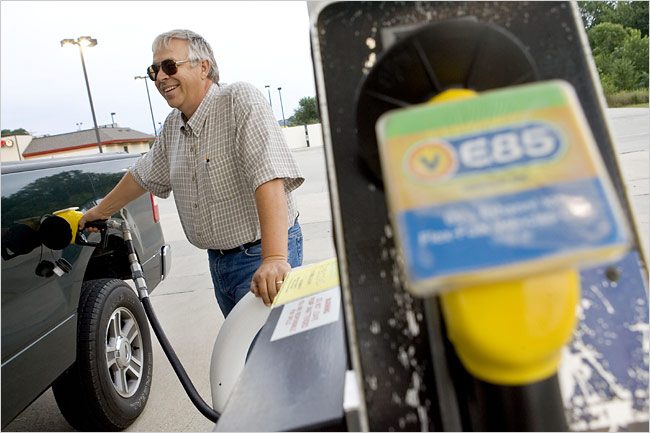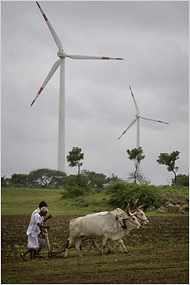In the face of rising gas prices and increasing turmoil in the Middle East, President Barack Obama called for a one-third cut in oil imports by 2020. The President’s plan to accomplish this goal relies on a variety of domestic energy sources including increased oil production and natural gas powered fleet vehicles.
But the aspect of the President’s plan that is of particular interest to our company is his call to increase biofuels production and use. Specifically, the President wants to break ground on at least four commercial-scale refineries producing cellulosic ethanol or advanced biofuels within the next two years that can help launch next generation biofuels in America.
That caught our interest because we have been working for a decade to commercialize cellulosic ethanol. In fact, our CEO went to Washington to testify to the Senate Agriculture Committee about the progress we’ve made on cellulosic ethanol and how policy makers can help us bring this project over the finish line. In his written testimony, Jeff Broin wrote:
My company has been making steady progress toward the commercialization of cellulosic ethanol for more than a decade. But the 2007 Renewable Fuel Standard, along with support from the Department of Energy and the Iowa Power Fund, allowed us to dramatically speed up our efforts. Today, we have an operating pilot facility producing cellulosic ethanol from corn cobs and light stover and plans to construct a full-scale commercial plant later this year.
Our model for cellulosic ethanol builds on the foundation of our 1.7 billion gallons of corn ethanol production capacity. We will bolt cellulosic technology onto our corn ethanol plants so that we can benefit from the infrastructure that is already in place and our existing relationships with farmers, many of whom are investors in those plants. The corn ethanol plants will also become more efficient because a byproduct of the cellulosic will be used to power both the cellulosic and corn ethanol production facilities. Because we use a waste product to produce cellulosic ethanol and generate power, an independent report found that our process reduces greenhouse gas emissions by 111 percent in comparison to gasoline. Cellulosic ethanol is a carbon sink, not a carbon producer.
Nearly 100 people at POET are working on this project and our partners include universities, all levels of government, technology developers and hundreds of farmers. All are motivated to increase the production of clean, domestic energy.
This first project alone will create about 300 jobs and launch an industry that will create almost 90,000 direct jobs just by meeting minimum targets in the Renewable Fuel Standard.
Today, we are producing cellulosic ethanol from the abundance of corn crop residue in the Midwest. In the future, we can also produce it from Georgian wood chips, Arkansas rice hulls and other sources of biomass that exist in all 50 states of America. POET put forth a plan to produce 3.5 billion gallons of cellulosic ethanol by 2022. We will get there by adding cellulosic technology to our existing plants, licensing it to other ethanol producers and by getting into new raw materials like wood chips, energy grasses and waste products.
But we can’t get there without stable government policy.
He goes on to talk about the impact that policy instability has had on the farmers we have contracted with and the investment community. We’ve been making tremendous headway in developing the logistics chain necessary to supply our commercial biorefinery with 300,000 tons of biomass per year. You can read about our efforts on our cellulosic ethanol blog. We have been assisted in that effort by the USDA’s Biomass Crop Assistance Program (BCAP) that matches payments to the farmers up to $45 per ton. But when legislation was introduced to eliminate BCAP it planted seeds of doubt in the minds of the 85 farmers who signed contracts with us and could make it harder to sign the additional contracts we will need to reach commercial scale.
Similarly, the investment community has received mixed signals from policy makers as uncertainty has arisen about the future of the Department of Energy’s loan guarantee program. Jeff Broin was one of 34 CEOs of renewable energy companies who signed a letter calling on Congress to fully fund the loan guarantee program.
Finally, cellulosic ethanol is challenged by a lack of access to the marketplace. Because ethanol is currently limited to ten percent of the fuel market, we are currently exporting affordable ethanol at the same time we are importing expensive foreign oil. That’s why we have proposed phasing out the current ethanol tax credit and using the funds to install blender pumps that allow consumers to choose their blend of ethanol: 10, 20, 30, 40 or 85 percent.
Is it a realistic goal to have four biorefineries producing next generation biofuels in two years, especially considering the challenges listed above and that we are falling short of the production levels required by the Renewable Fuel Standard? It’s a fair question and I’m not sure I can provide a definitive answer. However, I believe that it’s a worthy goal and one that we are prepared to help meet. With policy stability and a loan guarantee we will start construction on one of those four facilities later this year. And having the President solidly behind the effort, sure can’t hurt.
Follow the Inspired Economist on twitter.


